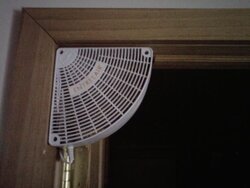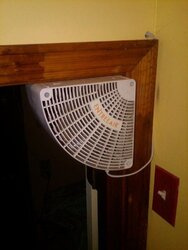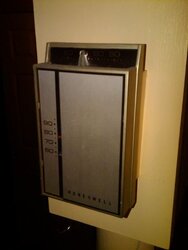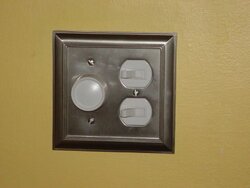I am putting a wood boiler system in our commercial property, but we also have a small house that started as a trailer and was heavily modified and has a really nasty forced air furnace that does not really heat the building but at least stops us freezing.
At some point I want to replace it with a passive solar design I can heat with a candle, but will not happen for at least a few years if ever.
I am not interested in getting up in the middle of the night for a wood stove, a pellet stove would cost a lot less than any other option. And I am fed up burning Propane and still being cold.
I am going to tighten up the structure, but still going to be not that good. It is about 1,000 sq ft, but we are at just under 10,000ft and have massive temperature swings. Lowest this year was -40 fortunately no wind, -20 is a more common low. This time of year 5 at night and 25 in the day is more normal. 45 tomorrow so a 85 swing in a week. HDD is 10,500.
During the day the sun keeps the place above 50 usually, Furnace will come on occasionally if we have a cold or cloudy day.
My calcs and gut feel both came up with a reasonable peak load of 40,000btus
I can get Confluence Pellets locally for $208 a ton. Seems a pretty constant price and I have been told that they have improved this year.
Looking on this board today I came up with the following:
Heatilator PS50 - 50,000 btus gross, so 40,000 btus net less altitude
2 bag hopper so should keep the place warm, if we are away for a few days. I want to minimse furnace use, see if it can limp through a few more years. To replace the furnace is $3,000, the PS50 plus horizontal chimney would be $1900. We are on Propane at $2 a gallon last refill, would not be surprised to see it back at $3 this year.
1. We are going to use Garns for the Hotel, they come with a high altitude fan. There seems no options for Pellet Boilers. What should I reasonably downrate?
2. I see mention of the need for High Altitude changes in make up air and chimney. But not what they are.
3. I was going to vent through the west wall horizontally, basically because it is cheaper and there are no doors or windows we would open during the winter on that side. The wind comes from the North. We have a reliable Electricity supply, the issue with a power failure I can live with. Seems common but vertical is more recommended by the manufacturers. Is it that big a deal?
4. I would only use a foot or so of chimney pipe, I was going with 3 inch. I will have the OAK and the only other thing is to ground it and bolt it.
5. I can not put it in the middle, best I can do is about 2/3rd towards the cold (north) end. So I am relying on convection. I see them being used for much larger buildings and am slightly concerned about the heat spread, do you keep your doors open, use fans? I was hoping that heating the living room/kitchen to 70 ish would mean the bedrooms/bathrooms were 60 ish.
This ended up rather long, would be grateful for any comments.
At some point I want to replace it with a passive solar design I can heat with a candle, but will not happen for at least a few years if ever.
I am not interested in getting up in the middle of the night for a wood stove, a pellet stove would cost a lot less than any other option. And I am fed up burning Propane and still being cold.
I am going to tighten up the structure, but still going to be not that good. It is about 1,000 sq ft, but we are at just under 10,000ft and have massive temperature swings. Lowest this year was -40 fortunately no wind, -20 is a more common low. This time of year 5 at night and 25 in the day is more normal. 45 tomorrow so a 85 swing in a week. HDD is 10,500.
During the day the sun keeps the place above 50 usually, Furnace will come on occasionally if we have a cold or cloudy day.
My calcs and gut feel both came up with a reasonable peak load of 40,000btus
I can get Confluence Pellets locally for $208 a ton. Seems a pretty constant price and I have been told that they have improved this year.
Looking on this board today I came up with the following:
Heatilator PS50 - 50,000 btus gross, so 40,000 btus net less altitude
2 bag hopper so should keep the place warm, if we are away for a few days. I want to minimse furnace use, see if it can limp through a few more years. To replace the furnace is $3,000, the PS50 plus horizontal chimney would be $1900. We are on Propane at $2 a gallon last refill, would not be surprised to see it back at $3 this year.
1. We are going to use Garns for the Hotel, they come with a high altitude fan. There seems no options for Pellet Boilers. What should I reasonably downrate?
2. I see mention of the need for High Altitude changes in make up air and chimney. But not what they are.
3. I was going to vent through the west wall horizontally, basically because it is cheaper and there are no doors or windows we would open during the winter on that side. The wind comes from the North. We have a reliable Electricity supply, the issue with a power failure I can live with. Seems common but vertical is more recommended by the manufacturers. Is it that big a deal?
4. I would only use a foot or so of chimney pipe, I was going with 3 inch. I will have the OAK and the only other thing is to ground it and bolt it.
5. I can not put it in the middle, best I can do is about 2/3rd towards the cold (north) end. So I am relying on convection. I see them being used for much larger buildings and am slightly concerned about the heat spread, do you keep your doors open, use fans? I was hoping that heating the living room/kitchen to 70 ish would mean the bedrooms/bathrooms were 60 ish.
This ended up rather long, would be grateful for any comments.






